Physical Address
304 North Cardinal St.
Dorchester Center, MA 02124
The authors thank pp-science-editing.com for editing and linguistic revision of the manuscript. Preparation of this chapter was carried out in part with grants from the Universidad CEU—San Pablo, and the Ministerio de Economía y Competitividad (SAF2015-70747-R) of Spain. CIBEROBN is an initiative of the Instituto de Salud Carlos III (ISCIII), Spain.
Changes in maternal lipid metabolism during gestation control the availability of lipid metabolites to the fetus, even though some components do not directly cross the placental barrier. This is the case with maternal plasma lipoproteins, the profile of which differs markedly during pregnancy from that seen in nonpregnant subjects. Although no evidence exists for the transfer of maternal lipoproteins to the fetus, placental cells have lipoprotein receptors that allow their uptake and the subsequent release of their lipid components to the fetus. However, other products of maternal lipid metabolism, such as nonesterified fatty acids (NEFAs), glycerol, ketone bodies, and cholesterol, are able to cross the placenta and become available to the fetus without prior modification. Although the efficiency of transfer across the placenta differs for each of these metabolites, the major force controlling their actual transfer is the maternal-fetal concentration gradient.
Maternal hypertriglyceridemia is one of the most striking changes that takes place in lipid metabolism during gestation. The increase in plasma triglycerides during pregnancy is greater than the increases in phospholipids and cholesterol, , and more triglycerides are found in all of the lipoprotein fractions. , As shown in Fig. 31.1 , although both triglycerides and cholesterol in very low-density lipoproteins (VLDLs), low-density lipoproteins (LDLs), and high-density lipoproteins (HDLs) are higher in pregnant women in the third trimester of gestation than in the same women during the postlactation period, the triglyceride-cholesterol ratio remains stable in VLDLs despite significant increases in both LDLs and HDLs. An examination of different HDL subclasses indicates that the rise in triglyceride-enriched HDL 2b is mainly responsible for the changes in HDL levels, whereas the small HDL 3 fractions become less abundant. The increase in triglycerides per LDL particle is accompanied by a decrease in cholesterol and phospholipid content, which causes reductions in LDL particle size, although increases in the most buoyant of the LDL subfractions, LDL 1 , have been reported with advancing gestation.
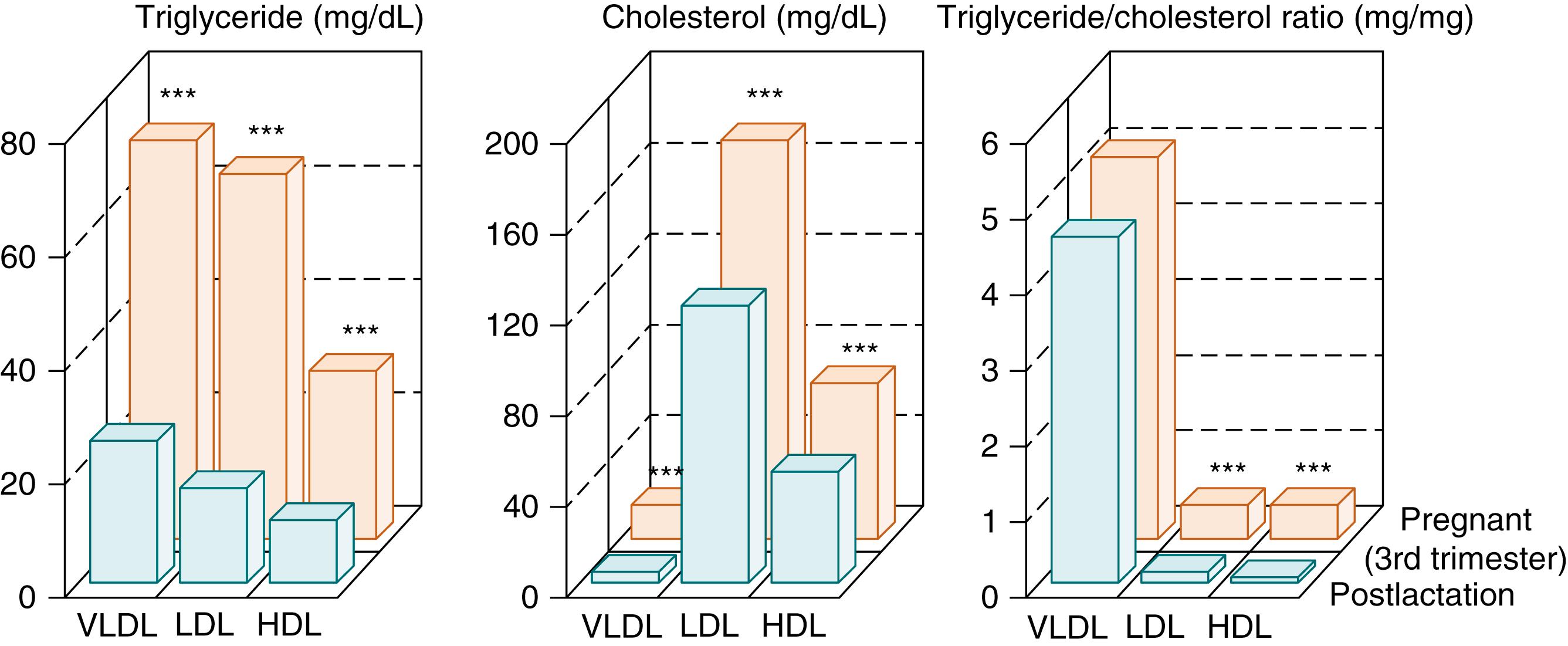
The mechanisms responsible for these changes in the maternal lipoprotein profile during pregnancy are summarized in Fig. 31.2 . The increased adipose tissue lipolytic activity during late gestation , (which is mediated by an insulin-resistant condition ) enhances the availability of substrates for triglyceride synthesis in the liver. The triglycerides thus produced become pooled with the lipid components derived from the uptake of chylomicron remnants. These actions, together with the stimulating effect of estrogen on VLDL production and the decreased extrahepatic lipoprotein lipase (LPL) activity, , are responsible in part for the augmented levels of circulating maternal VLDL in late pregnancy. The change in LPL activity corresponds to its decrease in adipose tissue, which is the body tissue that normally has the highest LPL activity and is the only tissue that shows a marked decrease during late gestation. , The decreased adipose tissue LPL activity is also a consequence of the insulin-resistant state characteristic of late pregnancy. ,
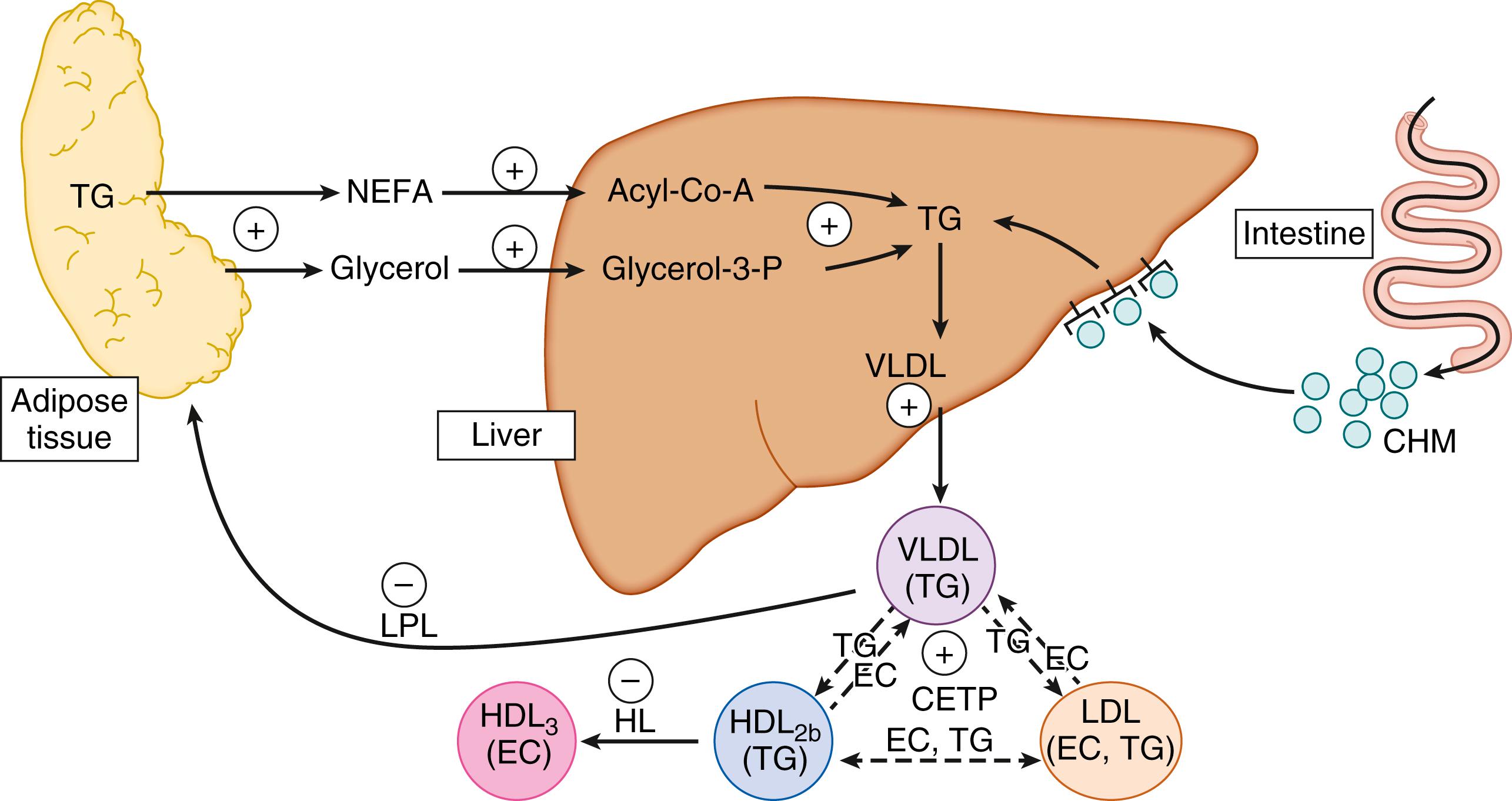
The specific enrichment in triglycerides seen in LDL and HDL seems to be the result of two mechanisms (see Fig. 31.2 ): (1) augmented activity of the cholesteryl ester transfer protein (CETP), , which mediates the transfer of esterified cholesterol from LDL and HDL 2b to VLDL in exchange for triglycerides, therefore contributing to the enrichment of triglycerides in the higher-density lipoproteins, LDL and HDL 2b ; and (2) decreased activity of hepatic lipase (HL), , therefore reducing the conversion of triglyceride-rich HDL 2b into the lipid-poor HDL 3 . The decreased HL activity during late gestation may be a response to the increase in estrogens, because these hormones are known to inhibit both HL activity and messenger RNA (mRNA) expression. , ,
The events just summarized together with the changes in other hormones and cytokines that take place during late pregnancy are responsible for the maternal insulin-resistant condition and for the sustained maternal hyperlipoproteinemia. Despite the impermeability of the placenta to lipoproteins, their lipid components do become available to the fetus; therefore the changes actively contribute to fetal development. In fact, reducing maternal hyperlipoproteinemia in rats by treatment with hypolipidemic drugs has detrimental effects on fetal development. ,
Essential fatty acids (EFAs) and long-chain polyunsaturated fatty acids (LCPUFAs) derived from the maternal diet are transported mainly in their esterified form in maternal plasma lipoproteins, rather than in their NEFA form, , and must become available to the fetus despite the lack of a direct placental transfer of maternal lipoproteins. The transfer occurs thanks to the presence of lipoprotein receptors in the placental trophoblast cells that lie at the interface with maternal blood. These cells are therefore positioned to bind maternal lipoproteins and mediate their metabolism and the subsequent transfer of the fatty acids they carry to the fetal circulation. VLDL/apolipoprotein E (apo E) receptor (VLDLR) and LDL, HDL, and scavenger receptors are expressed in human placental tissue. Furthermore, placental tissue has different lipolytic activities, including endothelial lipase (EL) , LPL, and phospholipase A 2, and intracellular lipase activities. , Consequently, esterified fatty acids of maternal plasma lipoproteins are hydrolyzed either extracellularly before uptake or intracellularly after receptor mediated endocytosis. After uptake they are reesterified before eventual release (see later). Using cultured placental trophoblast cells, it has been shown that esterified lipids provide a reservoir of fatty acids that can be released into the experimental medium. The placenta also has different fatty acid transport and binding proteins that actively contribute to the transfer of those fatty acids to the fetal circulation. ,
The mechanism by which placental fatty acids are released into the fetal circulation is not completely understood. One possibility is in the form of NEFA after the intracellular hydrolysis of esterified fatty acids in the placenta. In the fetal circulation these NEFAs would bind to a specific oncofetal protein, α fetoprotein, and be rapidly transported to fetal liver. Fatty acids taken up by fetal liver are esterified and released back into circulation in the form of VLDL-triglycerides. Another possibility is release to the fetal circulation in their esterified form associated with specific lipoproteins. This mechanism is consistent with the report that rat yolk sac can synthesize apo B–containing lipoproteins and that the placenta can express apo B ; similar findings have also been reported in mouse yolk sak , and in the human placenta. Both of these possibilities are consistent with the findings that the concentrations of certain polyunsaturated fatty acids (PUFAs) in maternal plasma triglycerides during late gestation in humans are significantly and positively correlated with their concentrations in cord plasma triglycerides and that the concentration of all individual fatty acids in serum during late pregnancy were lower in cord serum than in maternal serum. It also agrees with the finding that concentrations of esterified fatty acids were higher than those of NEFAs in venous cord plasma after the oral administration of different fatty acids to pregnant women at term before elective caesarean section. A linear correlation has also been found between maternal and fetal plasma triglycerides and PUFAs in the rat. , This relationship may have important implications for newborn weight because a direct relationship between maternal triglycerides and newborn weight has been found in humans.
During the first part of gestation, the maternal body accumulates fat , as the result of combined effects of hyperphagia, enhanced lipogenesis, and unmodified or even increased extrahepatic LPL activity. , , The tendency to accumulate fat ceases during late gestation , because maternal lipid metabolism changes to a catabolic condition. This is evidenced by increased adipose tissue lipolysis , and reduced uptake of circulating triglycerides, secondary to the reduction in adipose tissue LPL activity. , , These changes, together with very active hepatic production of triglycerides , and the increased absorption of dietary lipids are responsible for the marked progressive increase in maternal circulating triglycerides occurring during late gestation. , The major changes in the maternal lipid metabolism are summarized in Fig. 31.3 , which depicts the changes in adipose tissue, liver, and intestinal activity that are responsible for the physiologic increase in circulating NEFA, glycerol, and triglyceride-rich lipoproteins (VLDLs and chylomicrons). Under fed conditions, the frequency of maternal ketosis is not different from that in nonpregnant subjects, but it increases markedly under fasting conditions. ,
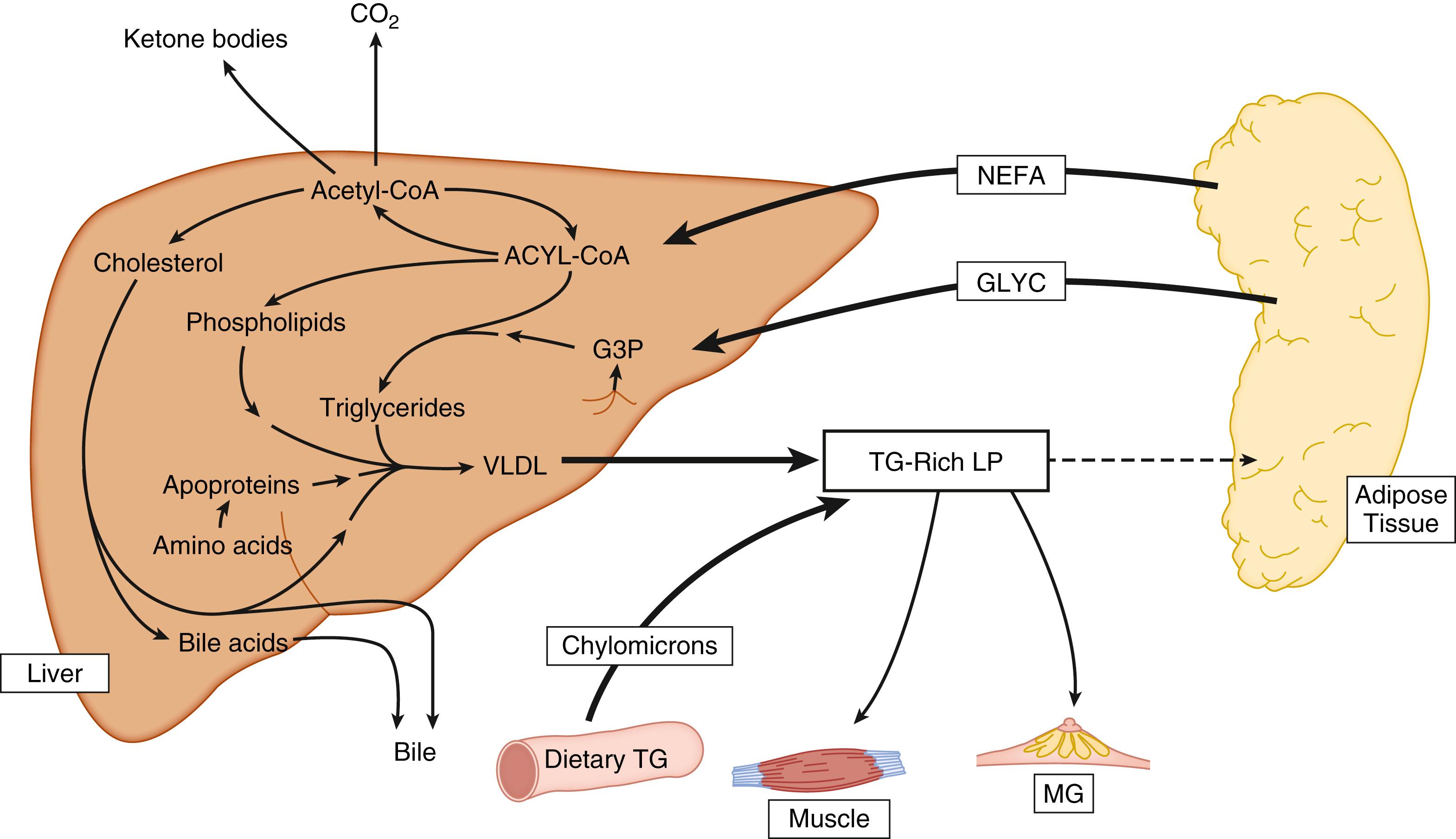
With the exception of glycerol used in gluconeogenesis , and the LPL-mediated uptake of circulating triglycerides by the mammary gland before labor, , , no part of the increase in circulating lipid components in the fed mother during late gestation seems to benefit her own metabolic needs directly. However, the increase may benefit the fetus because this gestational period coincides with the state of maximal fetal accretion, a time when the substrate, metabolic fuel and essential component requirements of the fetus are particularly prominent. The lipid component also may constitute a “floating” fuel store for both mother and fetus, easily accessible under conditions of food deprivation; this may explain the increased ketogenesis in the mother seen under fasting conditions. ,
The enhanced availability of ketone bodies to maternal tissues under fasting conditions allows them to be used as metabolic fuels, sparing other, more limited and essential substrates, such as amino acids and glucose, for transport to the fetus. Augmented lipolytic activity also increases maternal circulating glycerol levels. , Glycerol can be used by the mother as an efficient gluconeogenic substrate, , , contributing to the maintenance of glucose production for fetal and maternal tissues. Metabolic adaptations found in the mother during starvation are summarized in Fig. 31.4 . The transfer of glucose, ketone bodies, and amino acids is emphasized in this figure because quantitatively, they are the major substrates crossing the placenta in periods of starvation.
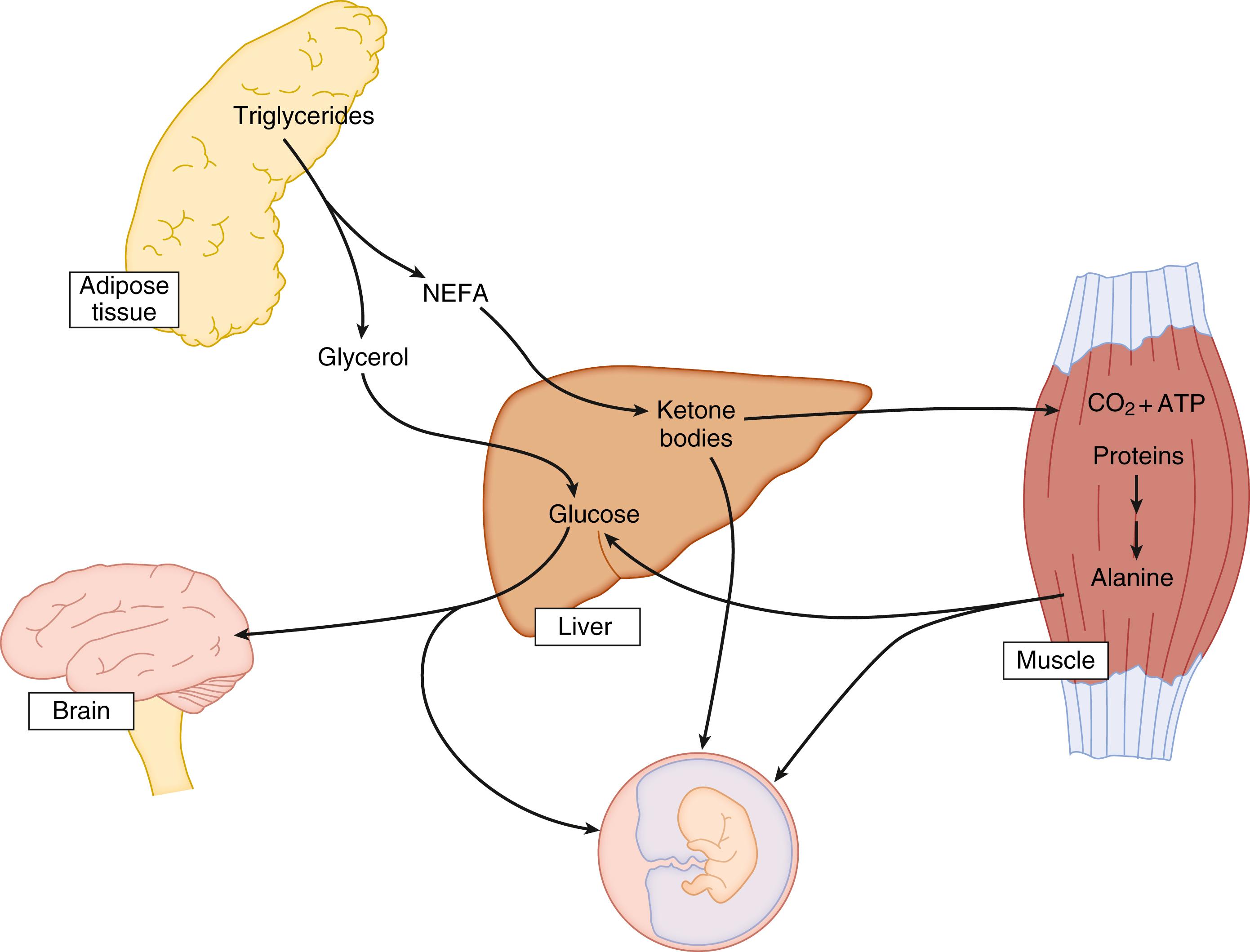
An understanding of fatty acid, glycerol, and ketone body placental transfer and their subsequent metabolic fates in the fetus provides an insight into the effect on the fetus of the persistently elevated maternal circulating lipid levels. Fig. 31.5 compares plasma levels of these metabolites in virgin and in 24-hour–fasted late-pregnancy rats and their fetuses. It can be seen that although fetal NEFA and glycerol levels are much lower in the fetuses than in their mothers, the concentrations of ketone bodies are similar. These maternal-fetal concentration differences probably reflect the efficiency or magnitude of the placental transfer process.
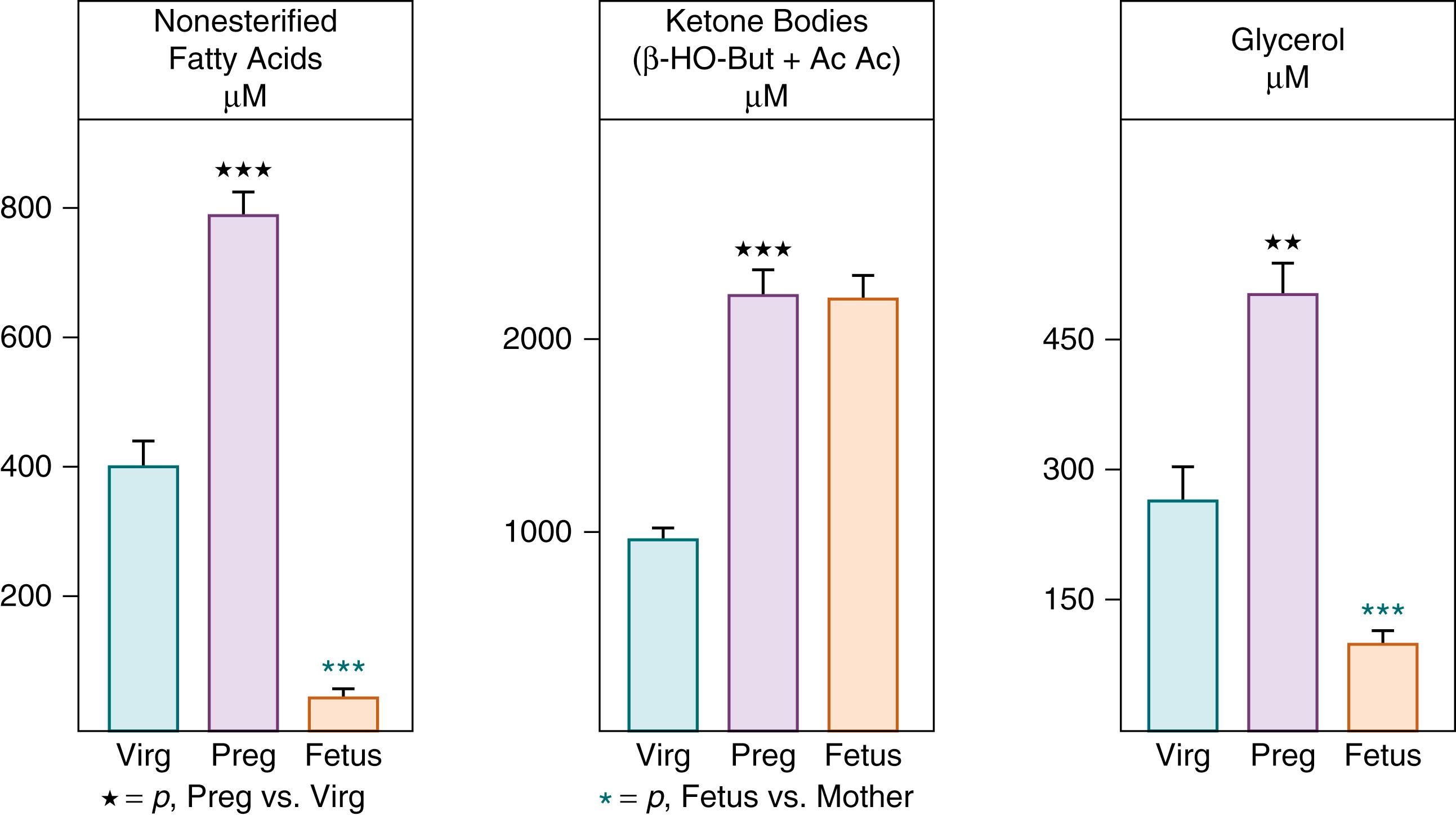
Maternal-fetal nutrient transfer through the placenta may be accomplished by different mechanisms, including facilitated diffusion, active transport, and simple diffusion. , The rate of transfer by simple diffusion is a direct function of the concentration gradient and decreases with the molecular size and hydrosolubility. However, in the case of placental transfer, other factors also play a role , : uterine and umbilical blood flows, intrinsic placental metabolism, and structural characteristics. As might be expected, some of these factors, such as blood flow, contribute analogously to the transfer of any nutrient, but other factors differ with each nutrient and require specific consideration.
Become a Clinical Tree membership for Full access and enjoy Unlimited articles
If you are a member. Log in here